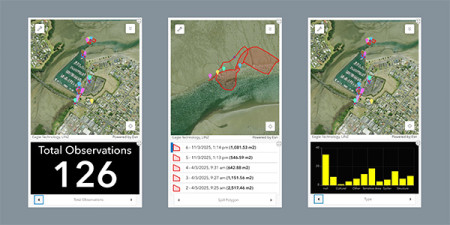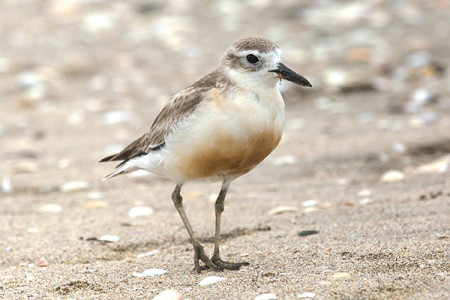“Working together with our staff, partners and stakeholders at these exercises allows us to build and maintain relationships and get a good understanding of each other’s capabilities.”
- Emergency Management Officer Andy BuBear

The oil spill response exercise in full swing at Whangamatā Marina
Whangamatā Marina is usually the picture of serene seaside relaxation and recreation. Not so on Tuesday, 11 March, when dozens of figures clad in hi-vis sprang to action for a marine oil spill response exercise.
Training exercises—like this one—are held biannually by Waikato Regional Council in different locations around the Waikato rohe (region). They enable our staff to practice the deployment of marine oil spill equipment that can minimise environmental harm. Maritime New Zealand staff attend and assess each exercise.
The bright orange rapid deployment booms, for example, are rolled out and used to contain or deflect oil. Land sea booms are filled with water and air to further protect shorelines. They can protect sensitive areas and help with the recovery of spilled oil.

Spatial analysts utilised cutting-edge geospatial tech during the exercise.
This equipment is large and bulky, and requires regular, specialist training to maintain the capabilities of our staff.
Our coastal habitats and ecosystems are diverse and highly valued for recreational, commercial and cultural reasons. And the Waikato region is certainly blessed with plenty of coastline.
Our coastal and marine environment spans the west coast from Mōkau in the south to Port Waikato in the north, and on the east coast, the Firth of Thames and the Coromandel Peninsula. From the high tide mark out to 12 nautical miles offshore, it covers a whopping 10,000km2 in area, including about 1150km of shoreline, and a water depth ranging from 0m to over 500m.

Dotterels were one of the coastal species identified as being at risk during the exercise.
But with this abundance of coastline comes a lot of responsibility.
“These exercises are a chance for our experienced responders and Maritime staff to practice skills in a realistic environment,” says Senior Emergency Management Officer Derek Hartley, who took the role of Regional On-Scene Commander (ROSC) for the emergency exercise.
“We were lucky to have many partners participate and observe what we do. In a few weeks we will start planning our next exercise which will be somewhere else in the Waikato.”
What’s a marine oil spill response team?
Council staff are drawn from a variety of areas, including specialists in marine oil spill emergency management, maritime safety, operations, health and safety, coastal and marine science, spatial information, and communications.
Partners from Maritime NZ, the Department of Conservation, Bay of Plenty Regional Council, and Fire and Emergency NZ were also present to lend their expertise during the exercise, and may also form part of a response team.
Over 40 people took part in the March exercise, working together to refresh the response team’s expertise in deploying a range of equipment, including two types of booms, oil skimmers and oil holding tanks.
New technology was also tested out, with GIS experts from our council’s spatial information team trialling the use of drones to assist in intelligence gathering. Coupled with a mobile GIS app, the drone’s GPS and visual tracking were used to capture simulated oil spill extents. These, together with any collected attributes, images and metrics, are then immediately viewable to anyone involved as shown in the dashboard examples.
For Dilshan De Silva, a spatial analyst at Waikato Regional Council, it was the first time participating in marine oil spill response training.
Taking part was an “invaluable learning experience, revealing the complexities of marine oil spill response and the effectiveness of multi-agency IMT (Incident Management Team) coordination”.
“The ability to witness cutting-edge geospatial technology deliver real-time intelligence was particularly impactful,” Dilshan says.
Outcomes of these equipment-based deployment exercises include consolidating knowledge for our trained staff, building confidence, engagement with stakeholders, and ensuring familiarity with the requirements of the Waikato Regional Marine Oil Spill contingency plan.
“Working together with our staff, partners and stakeholders at these exercises allows us to build and maintain relationships and get a good understanding of each other’s capabilities. We would like to especially thank the Whangamatā Marina Staff who allowed us use of the marina facilities and played a role in the exercise,” said Emergency Management Officer Andy BuBear, who took the role of Exercise Control for the training event.
When regional councils get involved
Regional councils are responsible for Tier 2 oil spills which are within 12 nautical miles of the coastline and/or have the likelihood of associated costs of not more than $250,000 for the response and clean up.
Maritime NZ covers the cost of training exercises, while costs associated with marine oil spill responses will fall to the person or organisation responsible for the spill.
The impact of a marine oil spill can vary depending on factors such as location, weather conditions, tide and the quantity and type of oil involved. The aim in any marine oil spill response is to prevent further pollution, contain and clean up the spill to minimise the impact on the environment, including plants and animals, and sensitive industries such as marine aquaculture.
Oil isn't always the name you'll hear describing what's been spilt. When we talk about oil spills, we mean the spillage of any contaminants that are crude or refined petroleum products, such as diesel, gasoline, kerosene, lubricating oils, etc.
Kit Squires, a coastal specialist at Waikato Regional Council, served as Oiled Wildlife Response Team (OSWRT) lead.
“The oil spill training exercise was a great day to emphasise the protection of wildlife, and to minimise the impact on our precious ecosystems,” he says.
“Native birds are often the most vulnerable, even to small amounts of oil, so keeping them out of harm’s way is a top priority during an oil spill response."
How to avoid oil spills
Our team might be well prepared, but avoiding potential marine oil spills is always our top priority.
So, what can you do to reduce the chance of an oil spill occurring?
- Don't leave the fuel pump unattended when refuelling.
- Have clean-up material handy during refuelling.
- Regularly check fuel lines and tanks for faults.
- Ensure bilges are kept as oil-free as possible, especially if using automated bilge-pumping systems.
If you have a spill, make sure you report it as soon as possible. Call Waikato Regional Council's freephone 0800 800 401.

